The NVIDIA GeForce RTX 2070 Founders Edition Review: Mid-Range Turing, High-End Price
by Nate Oh on October 16, 2018 9:00 AM ESTPower, Temperature, and Noise
As always, we'll take a look at power, temperature, and noise of the RTX 2070 Founders Edition, especially considering its atypically large GPU, new cooler design, new fixed-function hardware, and higher TDPs. For the most part, the dual axial fan open air design provide straightforward benefits in lower noise and cooling, though with drawbacks as mentioned earlier.
As this is a new GPU, we will quickly review the GeForce RTX 2070's stock voltages and clockspeeds as well.
| GeForce Video Card Voltages | |||||
| RTX 2070 Boost | GTX 1070 Boost | RTX 2070 Idle | GTX 1070 Idle | ||
| 1.050v | 1.062v | 0.718v | 0.625v | ||
The voltages are broadly comparable to the preceding 16nm GTX 1070. In comparison to pre-FinFET generations, these voltages are exceptionally lower because of the FinFET process used, something we went over in detail in our GTX 1080 and 1070 Founders Edition review. As we said then, the 16nm FinFET process requires said low voltages as opposed to previous planar nodes, so this can be limiting in scenarios where a lot of power and voltage are needed, i.e. high clockspeeds and overclocking. Of course, Turing (along with Volta, Xavier, and NVSwitch) are built on 12nm "FFN" rather than 16nm, but there is little detail on the exact process tweaks.
| GeForce Video Card Average Clockspeeds | ||||
| Game | RTX 2070 | RTX 2070 FE | GTX 1070 | |
| Max Boost Clock |
2160MHz
|
2160MHz |
1898MHz
|
|
| Boost Clock | 1620MHz | 1710MHz | 1683MHz | |
| Battlefield 1 | 1723MHz | 1825MHz | 1787MHz | |
| Far Cry 5 | 1734MHz | 1824MHz | 1784MHz | |
| Ashes: Escalation | 1775MHz | 1853MHz | 1774MHz | |
| Wolfenstein II | 1644MHz | 1719MHz | 1728MHz | |
| Final Fantasy XV | 1690MHz | 1786MHz | 1749MHz | |
| Grand Theft Auto V | 1802MHz | 1881MHz | 1832MHz | |
| Shadow of War | 1669MHz | 1775MHz | 1768MHz | |
| F1 2018 | 1780MHz | 1826MHz | 1787MHz | |
| Total War: Warhammer II | 1743MHz | 1833MHz | 1786MHz | |
In terms of clockspeeds, the RTX 2070 isn't bringing any surprises. Like Pascal and the GTX 1070, the boost clock reading is used liberally, usually boosting beyond, and varies per game/workload. With the +90MHz Founders Edition OC, the RTX 2070 dutifully ramps up. What remains to be seen is how these clockspeeds hold when RT cores or tensor cores are actively and steadily utilized. In any case, at its Founders Edition specs, the RTX 2070 has perhaps another 100MHz or so to push, but otherwise is out of headroom (or power).
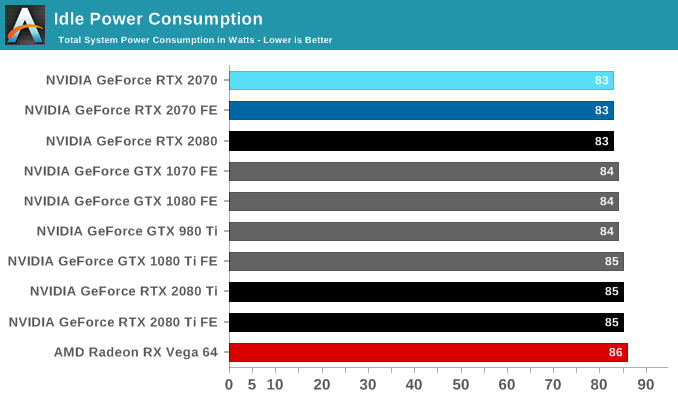
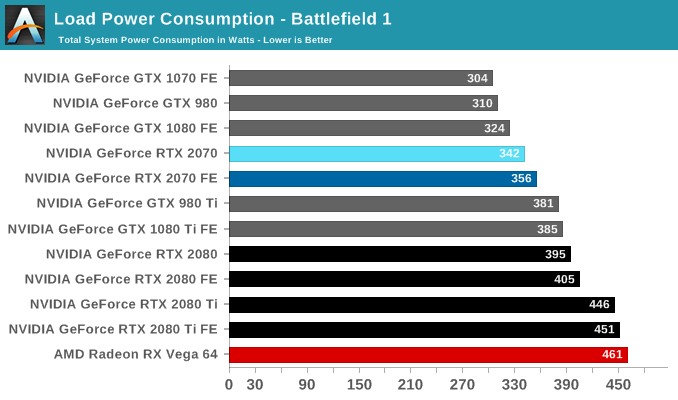
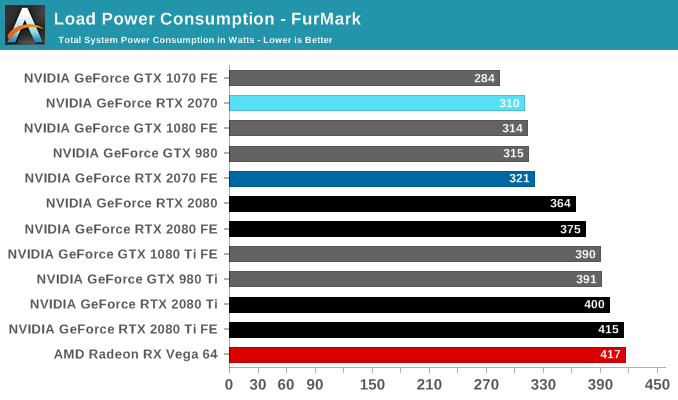
The steady TDP creep has taken its toll, and the 2070 is no longer a power-sipper of the likes of the 1070 or 970. At the very least, it is far from the excesses of its older 2080 Ti and 2080 siblings. Of note is its additional power draw over the GTX 1080, which in certain games trades blows with the 2070.
Temperature
The adoption of an open air cooler with dual axial fans has immediate benefits, especially with a lower temperature target.
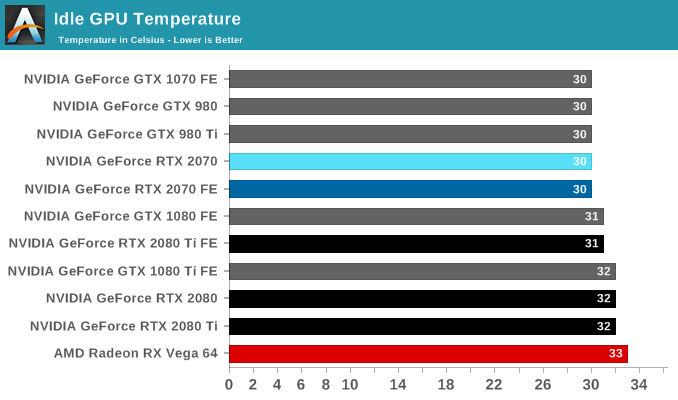
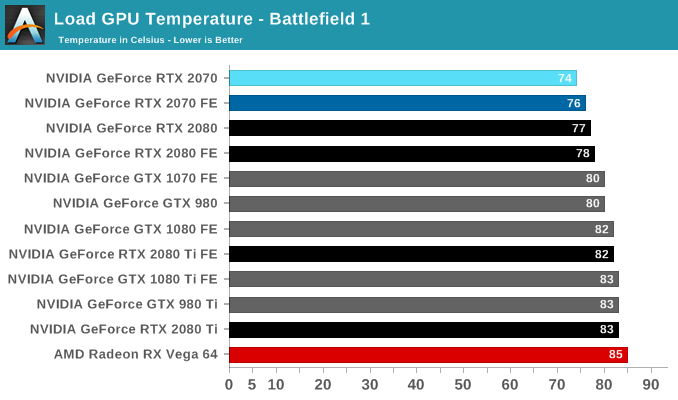
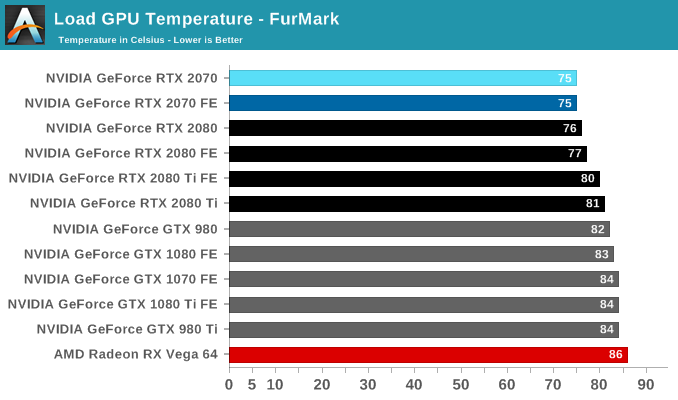
Noise
In turn, the open air cooler allows for quieter, slower spinning axial fans.

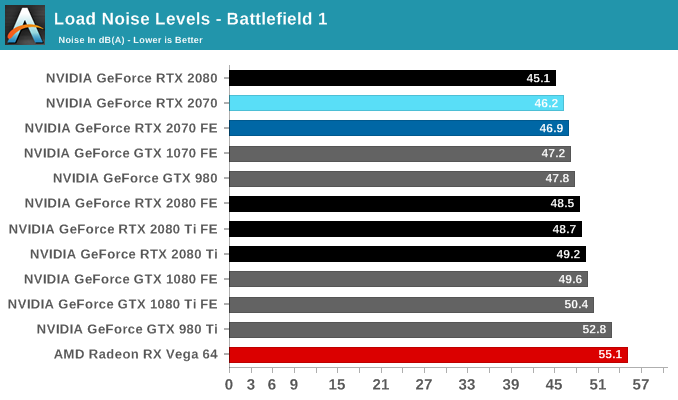
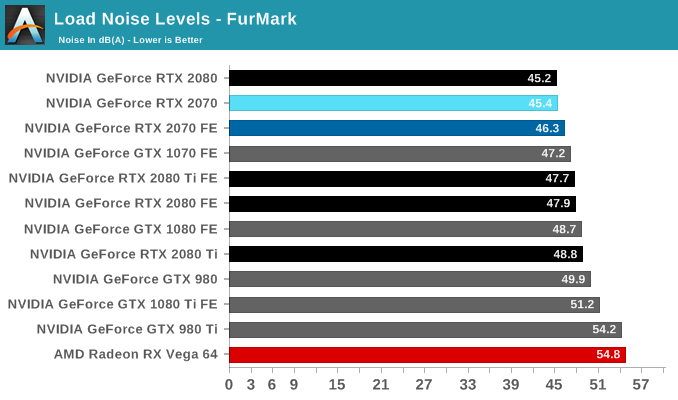










121 Comments
View All Comments
PeachNCream - Tuesday, October 16, 2018 - link
You've got a good graphics card in the 970 that should get you at least a couple more years of reasonable performance. If I were in your position, I wouldn't be in the market for a new GPU. However, I do sympathize with you when it comes to the cost it takes to be able to play these days and I agree that a shift to some form of console is a sensible alternative. PC hardware pricing has been on the rise in the last few years and it stings when you've come to expect performance improvements alongside cost reductions that we've been enjoying for the majority of the years since microcomputers found their way into homes in the 1980s.I think what's driving that is a diminishing market. Economies of scale don't work when there's no further growth for what's become a mature industry (PCs in general) and a declining segment (desktop PCs in specific) due to the slow shift of computing tasks to mobile phones. I don't see anywhere for desktop components to go but further up as we lean into the physical limits of the materials we have available while also contending with falling sales numbers. Compound that with the damage these prices will inflict on the appeal of PC gaming to the masses and we're starting to look at a heck of an ugly snowball on its way down the hill.
It's probably a good time to make a graceful exit like you're mulling over now. As someone else that's thrown in the towel, I can happily confirm there's lots of fun to be had on very modest, inexpensive hardware. From older games to low system requirements new releases, I have faith that there will always be a way to burn up a lot of free time at a keyboard even if you end up with very old, very cheap hardware.
WarlockOfOz - Wednesday, October 17, 2018 - link
Concur. I'm still rocking a 750Ti and feeling no need to upgrade it or the even older CPU (phenom x4) despite having money put aside. I'll replace when it breaks, like my fridge, unless something does make going past 1080p compelling - whether that's VR, ray tracing, or a must have game that I can't play at all.nikon133 - Tuesday, October 16, 2018 - link
I hear you.Been considering to make my current rig - older i7 (Haswel) with recently added 1070 - my last gaming PC. It really boils down to how next gen consoles turn out - but even as current gen is, I seem to be spending more time on PS4 than on gaming PC. In fact, MHW is the only game I am playing on PC atm, and event hat because of friends who insisted to play it on PC. Eventually, we are lucky if we get to play it together once a week, on average... definitely not worth investment into new rig, for me.
ingwe - Wednesday, October 17, 2018 - link
I mean you don't need the most top end or recent parts. I am gaming on a 5850 and i5-4670K (I think that is the model it has been so long I might be mixing things up). It runs great. 256 GB SSD and 16 GB of ram.The prices are crazy for the high end but you also don't need the highest end and most recent gen when performance improvements are marginal.
Farfolomew - Monday, October 22, 2018 - link
In the 486 days, computer gaming was worth that much money. The landscape was rapidly changing, games were rapidly changing. The internet was taking hold, 3D gfx starting to be born. It was amazing. It was money well spent to be able to play groundbreaking new types of games.Nowadays, although overall less expensive perhaps, your money doesn't buy you much new in terms of originality and exciting gameplay. All we get are prettier and prettier textures with duller and duller games. WoW and Counterstrike are STILL massively popular games, certainly not for their gfx.
Eris_Floralia - Tuesday, October 16, 2018 - link
Nate, iirc they handicapped the tensor performance of FP16 with FP32 accumulate, which is only half of those on equivlant Quadro cards, maybe that's why HGEMM performance is low.https://cdn.discordapp.com/attachments/47593159264...
Eris_Floralia - Tuesday, October 16, 2018 - link
*equivalentYojimbo - Tuesday, October 16, 2018 - link
The chart says half precision GEMM. So I think a lack of accelerated 32-bit accumulation should not be slowing the GPU down. As far as I know, the Turing Tensor Cores perform FP16 multiplications with FP16 accumulations at 8 operations per clock much like Volta Tensor Cores perform FP16 mults. with FP32 accumulation at 8 operations per clock.Eris_Floralia - Tuesday, October 16, 2018 - link
Turing FP16 with FP16 accumulate is fully enabled on all RTX cards, but FP16 with FP32 accumulate is 1/2 rate on GeForce cards.They used out of the box configuration which likely used Volta's FP16 with FP32 accumulate, resulting in half the performance.
HGEMM results for 2080TI/2080/2070 are very close to their 54/40/30 TFLOPS theoretical performance. If it was a Quadro card you will see double the performance with this config. If they updated the binary support, you'll likely see double the perf with FP16 accumulate too.
Yojimbo - Tuesday, October 16, 2018 - link
"They used out of the box configuration which likely used Volta's FP16 with FP32 accumulate, resulting in half the performance."It could be some driver error. But I don't see why the GPUs not having FP32 accumulate should be the ultimate cause for the poor results. I admit I don't know much about the test, but why should the test demand FP16 multiplications with FP32 accumulate? That's more or less an experimental situation only available commercially in NVIDIA's hardware, as far as I know. If the test is meant to use FP16 accumulate and FP32 is being forced in the test then the reason for the poor results is a driver or testing error, not that Turing GPUs only have FP16 accumulate at full Tensor Core speed for the precision.